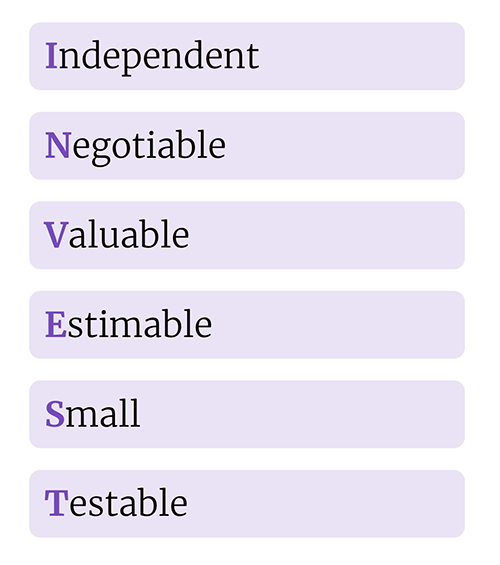Editor’s note: This article was reviewed and updated on 10 September 2024.

In agile software development, user stories enable both planning and execution. To enable planning, user stories serve as containers to express user needs clearly and concisely. To enable execution, user stories are written with business-friendly language to signal technical practitioners to the software components they need to build for a complete solution.
There are many techniques that agile practitioners use to write effective user stories, and in this article, we’ll take a look at one of those techniques — the INVEST principle, a set of guidelines that helps us evaluate a user story’s quality.
According to the INVEST criteria, good user stories are:
It’s common for teams to struggle with writing user stories, especially for teams that are relatively new to agile software development. Some of the most import attributes of user stories include the following:
A popular way to write user stories is to start with the following syntax:
As a [role/persona/user type]
I want [goal or action]
So that [desired result from goal/action]
For example, using this syntax, you could write a user story such as the following in an insurance or health care context:
As the primary applicant
I want to enter the passcode I received from my representative
So that I can access my account and ensure my claim information is accurate
One reason the syntax above is popular is that it helps teams remember to address each of the first three bullet points above (who, what, and why). Teams also write acceptance criteria as part of the user story, to make sure it’s clear what “done” means for that user story.
Writing user stories using syntax such as that described above is helpful. Still, there are other considerations that are important for teams to consider when writing user stories. Recognizing the need for a method to help teams avoid common pitfalls in agile software development, Bill Wake first articulated the INVEST principle in an Extreme Programming (XP) article in 2003.
INVEST is an acronym to help teams write high-quality, specific user stories that are independent, negotiable, valuable, estimatable, small, and testable. The INVEST principle in agile, therefore, is the practice or framework to follow when creating these user stories:

Let’s take a closer look at each one of the user story attributes associated with the INVEST principle.
An independent user story is one that is: 1) conceptually separate from other user stories, and 2) not reliant on the completion of other user stories.
The independent aspect is important because agile teams seek to surface any dependencies that exist and eliminate them whenever possible, and that can’t happen if the user stories depend on one another’s completion.
For example, suppose that a Scrum team is considering working on two user stories — we’ll call them A and B — during the same sprint. Work on story B cannot start until story A is done. If story A does not reach completion until the end of the sprint (or is unfinished), the team has put itself in a position where the likelihood of unfinished work is considerably higher. By doing so, the team has incurred schedule risk.
When a team approaches a user story as negotiable, it means the story is an “invitation to a conversation.” As the team gets more familiar with the story context, additional ideas may emerge, the wording of the story may change, and details may be added.
Agile teams leverage their combined wisdom to arrive at a good enough solution to address a particular user need, where “good enough” strikes a balance between value (meeting a real need), cost (being a reasonably small chunk of work), and complexity (aligning with the existing design/architecture).
This one is rather self explanatory. A completed user story has value when it meets an actual customer need.
One of the tenets of the Agile Manifesto is working software over comprehensive documentation, and that statement helps teams remember to keep customer needs top of mind. In much the same way, completion of each user story needs to be realized as actual value delivery, even if it’s a tiny change.
An estimatable user story is one that is understood well enough by team members to be able to determine its relative size. In practice, “relative size” means that given a set of user stories, team members can determine which stories are about the same size. T-shirt sizes such as small, medium, and large often serve as a helpful relative sizing construct.
It’s important to recognize that some teams don’t estimate user stories. Thus, being estimatable is synonymous with being reasonably close to ready to work on without too much additional conversation. On teams that do estimate, it also means they know enough about it to assign a size to it.
The S in INVEST stands for small. A small user story is one that can be completed during a short time window — for example, no more than a few business days.
This is important because teams that consistently work on small user stories are far more likely to finish stories than teams that struggle to keep their stories small.
A testable user story is one that can be verified to have met the story’s acceptance criteria (also known as “conditions of satisfaction”).
The clearest indication for a team to know that a story is done is for all of its tests to pass. User stories with vague or missing acceptance criteria are much more likely to surface as quality problems when in the hands of a customer.
When it comes to planning, Scrum follows a predictable cadence. There is a product backlog containing a prioritized list of user stories for a team to work on, and, on a recurring basis, members of the team clarify user stories and choose the ones to work on for the next sprint.
To do this, they focus on stories that are at or near the top of the product backlog (aka backlog refinement) and choose user stories to work on during their next sprint by placing selected stories in the sprint backlog (aka sprint planning).
By applying the INVEST criteria for user stories during backlog refinement and sprint planning, Scrum teams can realize benefits associated with each area of the INVEST principle:
Note: Teams that are not practicing Scrum can also realize benefits by applying the INVEST principle.
The INVEST principle aligns nicely with the following concepts:
Let’s get into these concepts in more detail.
The Three Cs is a concept first articulated by the agile practitioner and XP co-creator Ron Jeffries in an article in 2001, where the Cs represent:
The INVEST criteria align especially well with the conversation and confirmation parts of the Three Cs, since team understanding is most likely to be achieved for a user story when each of the six parts of INVEST surfaces during team conversation.
The DEEP principle also works well in tandem with the INVEST criteria for user stories. You can apply DEEP to the product backlog as a whole, while you can use INVEST to fully elaborate individual user stories in the product backlog.
Thus for any item in the product backlog, a team can see whether each of the following is true:
Here are a couple of related concepts that are especially important to understand in conjunction with the DEEP principle and with management of the product backlog in general:
Like so many things in the agile toolkit, the INVEST principle consists of a set of guidelines, not a rigid rule book. There are a lot of common misconceptions and mistakes to avoid when applying the INVEST principle, so here are some tips to keep in mind:

When inspecting and clarifying user stories, some details may become more clear only after development has started. There is no substitute for ongoing team communication to make sure everyone stays on the same page.
For example, it can be challenging when writing user stories to make the story’s business value apparent. Involving multiple members of the team when writing and clarifying stories helps ensure that the business intent and the expected business benefit are as clear as possible.
When articulating user stories, there is a fine line between “good enough” and “over the top.” For instance, a common anti-pattern when estimating is to spend a lot of time debating the size of a particular user story.
The INVEST principle has stood the test of time, by continuing to be popular among agile practitioners, both as a training tool, and in actual practice. By remembering to evaluate whether each story is independent, negotiable, valuable, estimatable, small, and testable, you too can improve team alignment and enhance your ability to deliver software that customers love.
Featured image source: IconScout

LogRocket identifies friction points in the user experience so you can make informed decisions about product and design changes that must happen to hit your goals.
With LogRocket, you can understand the scope of the issues affecting your product and prioritize the changes that need to be made. LogRocket simplifies workflows by allowing Engineering, Product, UX, and Design teams to work from the same data as you, eliminating any confusion about what needs to be done.
Get your teams on the same page — try LogRocket today.

A practical framework for PMs to use AI in ideation without sacrificing judgment, strategy, or decision quality.

A practical five minute revenue estimation method to help product managers compare ideas, drop low impact features, and prioritize smarter.

A practical guide for PMs who want to stop being bottlenecks, delegate smarter, and lead teams effectively with a clear ownership framework.

Stop letting unreliable data block features. Treat data as inventory to track quality, ownership, and ship with confidence.